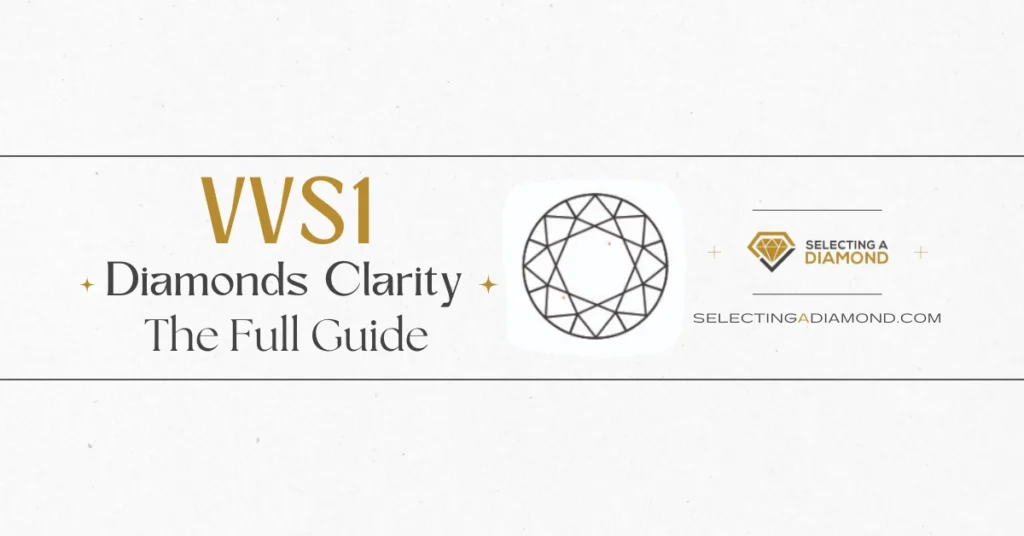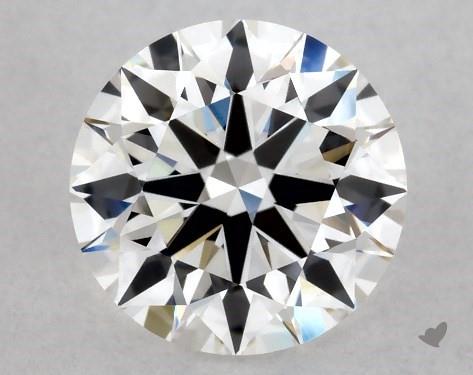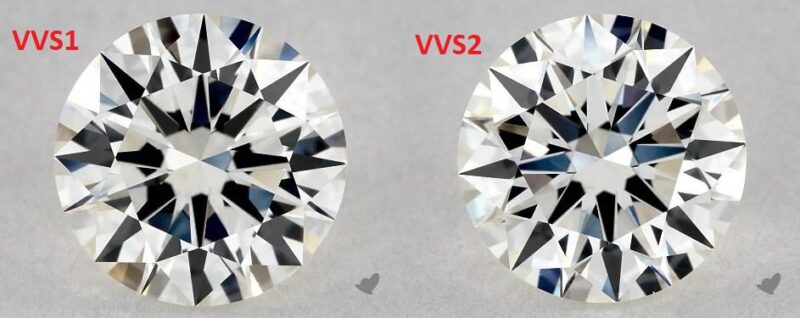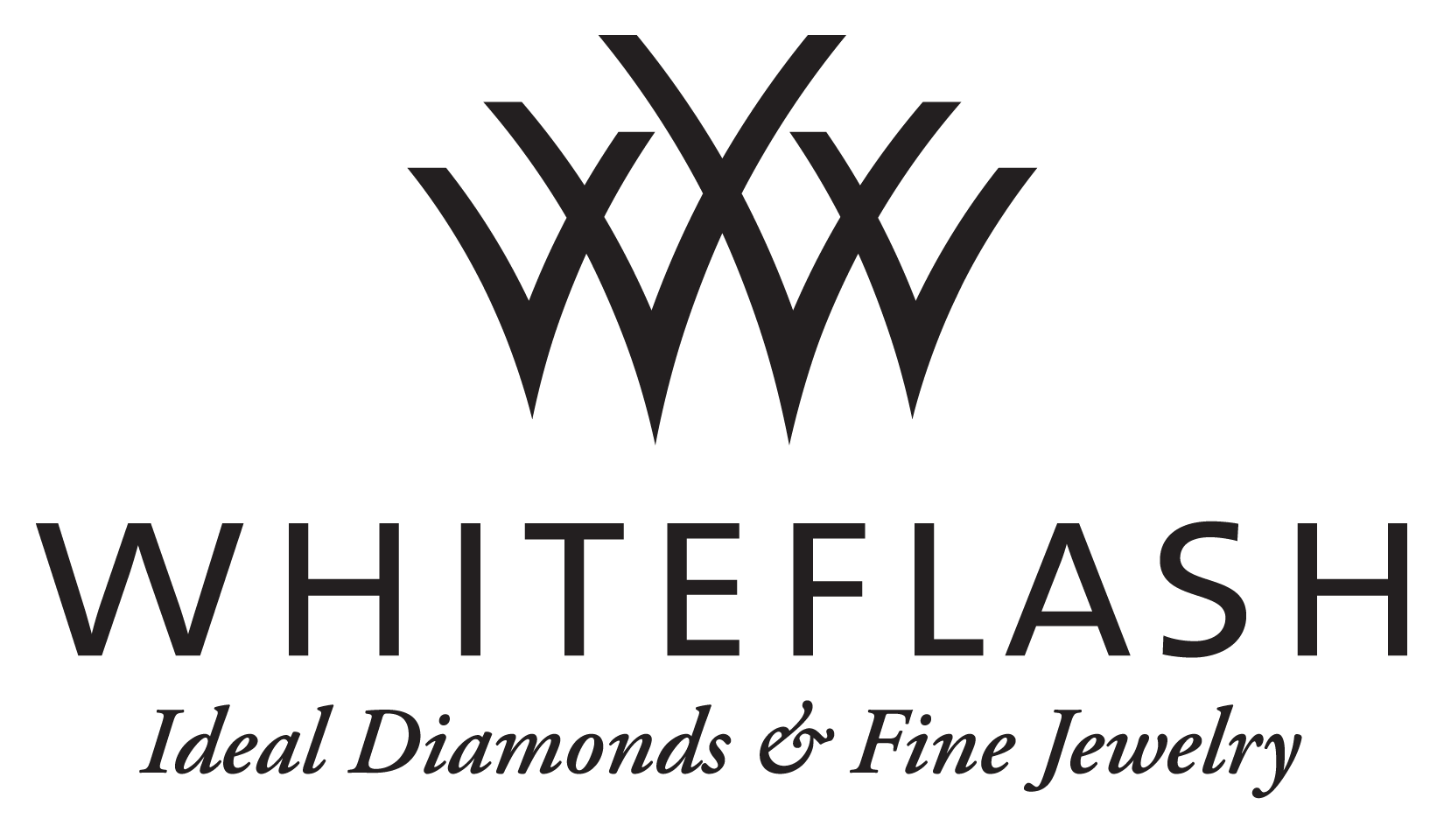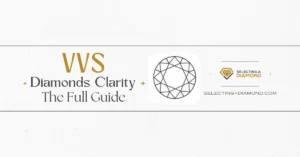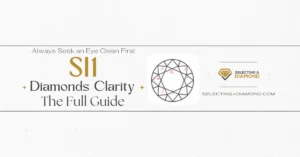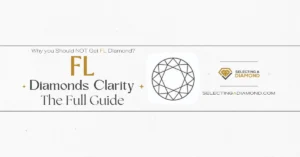We may earn a commission when you purchase through our affiliate links, at no extra cost to you. This helps support our work and allows us to continue providing unbiased, expert diamond advice.
Diamonds are a symbol of beauty, luxury, and everlasting love. Their unique and enduring qualities have made them one of the most coveted precious stones in the world. However, not all diamonds are created equal. One of the most important factors that determine a diamond’s value is its clarity.
This is where VVS1 diamonds come in.
VVS1 stands for “Very Very Slightly Included 1”, and it is one of the highest clarity grades that a diamond can receive. VVS1 diamonds have very few, tiny, and difficult-to-see inclusions when viewed under 10x magnification by a trained gemologist.
These inclusions are so small that they have no impact on the diamond’s overall appearance and brilliance.
This is an example of a magnificent 1.06c VVS1 diamond available on James Allen, priced at $9010:
Let’s learn a bit more about VVS1 diamonds.
What are VVS1 Diamonds?
Diamonds are formed deep within the earth under immense heat and pressure, which can create distinct marks that are categorized as either internal (inclusions) or external (blemishes).
To standardize this definition of clarity, and what’s the difference between diamonds in terms of how clean the diamond is, Clarity Grade Scales/Charts were created.
The most popular one, and globally accepted is the GIA Clarity Scale, which segmented all diamonds on earth into 6 groups containing 11 grades in total.
VVS1, which is short for Very Very Slightly Included comes as the 3rd grade from the top, at the same time it’s in the 3rd group (since each grade above is defined in a separate group per GIA classification).
So if we look at VVS1 from the top, it comes right after the Internally Flawless grade, which we learnt that it has no inclusions, but only minor blemishes that are only visible under skilled grader, and with very high magnification.
VVS1 isn’t much far from IF grade, the only difference is that VVS1 might have inclusions and/or blemishes, and both are extremely hard to detect, even under 10x magnification by skilled graders.
To make it clearer, VVS1 inclusions are extremely tiny, it might take a skilled grader either a couple of minutes or even more than 10x magnification to spot them.
What if this skilled grader is looking with their naked eye? VVS1 is the same as VS2 for them! They can never tell a difference using naked eye, and that’s for the skilled grader, we will leave it for you to think what will be the case for regular people.
VVS1 and VVS2: What’s the difference?
Not only size of inclusions matters here, location, number, and types of inclusions are taken into account when assessing a diamond clarity grade and assign it a VVS1.
The main difference between VVS1 and VVS2 is the time it needs a skilled grader to inspect an inclusion or a blemish.
While VVS1 inclusions might need a minute or two for an experienced grader to be seen (with 10x or more magnification), VVS2 imperfections can be detected in less than that, probably in 30 seconds or less.
VVS1 and VVS2 Visual Comparison
These two diamonds taken from James Allen are magnified not at 10x but at 20x, the left one is VVS1, and the other is VVS2, if you look from a clarity perspective, you can never tell any difference:
To better inspect the quality of diamonds, you can view & compare them in 360° HD view and 40x magnification, here is the VVS1 diamond, and then take a look at this similar diamond but with a VVS2 clarity.
VVS1 Diamonds Prices
Don’t expect that you can look at the prices of the 3rd best clarity grade ever and find some great or even “reasonable” prices.
VVS1 diamonds prices are expensive, due to the fact that these diamonds are considered relatively rare, no more than 2% of global diamond fall into this grade, no wonder it has high price tags, whether online or in your local jewelry store (which will be at least 30% more expensive than online).
As we regularly do, we use online diamond prices to get a better idea of diamond pricing, and in particular, we count on James Allen & Blue Nile for our reference here.
We ran a search on James Allen with predefined 4Cs and other characteristics (Excellent cut, ~1 carat, G color, Excellent polish & symmetry) and then noted the VVS1 diamonds price range.
Results show 182 diamonds, ranging between $6200 and $10000, again, this is for 1 carat diamonds.
When we analyzed 1 carat diamond pricing, we found that you can easily find a great diamond somewhere between $4400 and $6500.
We’re here talking about at least $2000 higher than the average 1 carat diamond, this becomes much more when we go with higher carat.
Doing the exact same exercise on Blue Nile gave us 137 diamonds, priced between $6800 and $11000.
Are VVS1 Diamonds Worth it?
If this is the first article you read on our site, we just want to make sure that we’re on the same page.
At Selecting A Diamond, we always encourage our readers to pay for what matters (and what matters only), and in terms of clarity, eye cleanliness is the ultimate thing you should rely on.
In other words, when you’re searching for a diamond and stop on the clarity selection, always seek the least eye clean grade, and don’t go crazy beyond that.
You might be surprised, but if you’re looking at 1 carat diamond or less, in 95% of cases, you can rest assure that a SI1 grade is eye clean grade.
Want to feel a little more safe or getting a higher carat, go VS2 and not more.
Where VVS1 Stands in Clarity Chart? Clarity Grades Quick Look
Going quickly over the clarity chart will help us visualize where each grade stands compared to others, in a nutshell:
- FL (Flawless): The diamond is completely free of blemishes and impurities.
- IF (Internally Flawless): No inclusions are present, but some minor blemishes may be visible under 10x (or even more) magnification.
- VVS1 (Very, Very Slightly Included 1): Inclusions are extremely difficult to see under 10x magnification, even for a trained grader.
- VVS2 (Very, Very Slightly Included 2): Inclusions are very difficult to see under 10x magnification, even for a trained grader.
- VS1 (Very Slightly Included 1): Inclusions are difficult to see under 10x magnification, and may be visible to a trained grader under magnification.
- VS2 (Very Slightly Included 2): Inclusions are somewhat difficult to see under 10x magnification, and visible to a trained grader under magnification.
- SI1 (Slightly Included 1): Inclusions can be seen under 10x magnification, but most probably invisible to naked eye.
- SI2 (Slightly Included 2): Inclusions are easy to see under 10x magnification, and may be visible to the naked eye.
- I1 (Included 1): Inclusions are obvious under 10x magnification and may be visible to the naked eye.
- I2 (Included 2): Inclusions are obvious under 10x magnification and are visible to the naked eye.
- I3 (Included 3): Inclusions are obvious under 10x magnification and are easily visible to the naked eye.
Visualizing these grades give us this chart:
Where to Buy VVS1 Diamonds?
If you visit a local jewelry store and ask for a VVS1 diamond, you will find no more than a handful of options available, and their prices will be much higher than what we saw above.
Browsing online gives a lot more options than this, large retailers like James Allen, Whiteflash, and Blue Nile offer thousands of VVS1 diamonds to pick from.
They come with advanced 360 images where you can inspect the diamond in 10x magnification, some figures about each of these on these stores as of now:
1. James Allen
Not only 20x magnification, but 40x and 360° HD images for all their collection, they currently show 19k+ round diamonds in VVS1 clarity grade you can browse from.
2. Blue Nile
Along with James Allen, they are both the largest diamond retailers online, with hundreds of thousands of diamonds.
Blue Nile offers real images (in 360 as well) for most of their collection (around 80% more or less), and they currently have 20k+ VVS1 round diamonds that you can see here.
3. Whiteflash
Whiteflash present themselves in a different way, they focus on quality rather than quantity, that’s why you won’t find thousands of diamonds there, but those available are fine-picked, and present ultimate quality in terms of cut & brilliance.
As of writing this, Whiteflash holds a collection of 67 round diamonds, each has high quality 360-degree video.
VVS1 Clarity Final Word
When it comes to diamond clarity, VVS1 diamonds are a rare and highly valuable option. These diamonds have very few inclusions that are extremely difficult to detect, even under 10x magnification.
Due to their exceptional clarity, VVS1 diamonds are quite expensive, costing $3000 or more than the average 1 carat diamond.
For those who are looking for a balance between clarity and affordability, diamonds in the VS2 to SI1 range may be a good choice. Although they have visible inclusions under magnification, they still appear eye-clean and offer a good balance of quality and value.
Still not sure where to buy your diamond?
We always recommend shopping diamonds online and created a Full guide to shop diamonds like a Pro.
Among online retailers, here are our favorite stores click their logo to visit store
-
James Allen:
Our favorite online store, best diamond imaging technology available today, comes with the largest collection with more than half a million loose diamonds.
-
Blue Nile:
Widest collection of loose diamonds of all sizes, great imaging technology for most of their inventory (hundreds of thousands of diamonds), great customer support.
-
Whiteflash:
Home Of A CUT ABOVE® Super Ideal Diamonds, they stand out from the crowd by offering premium diamonds cuts, tailored to those who love the details, at great prices too.

